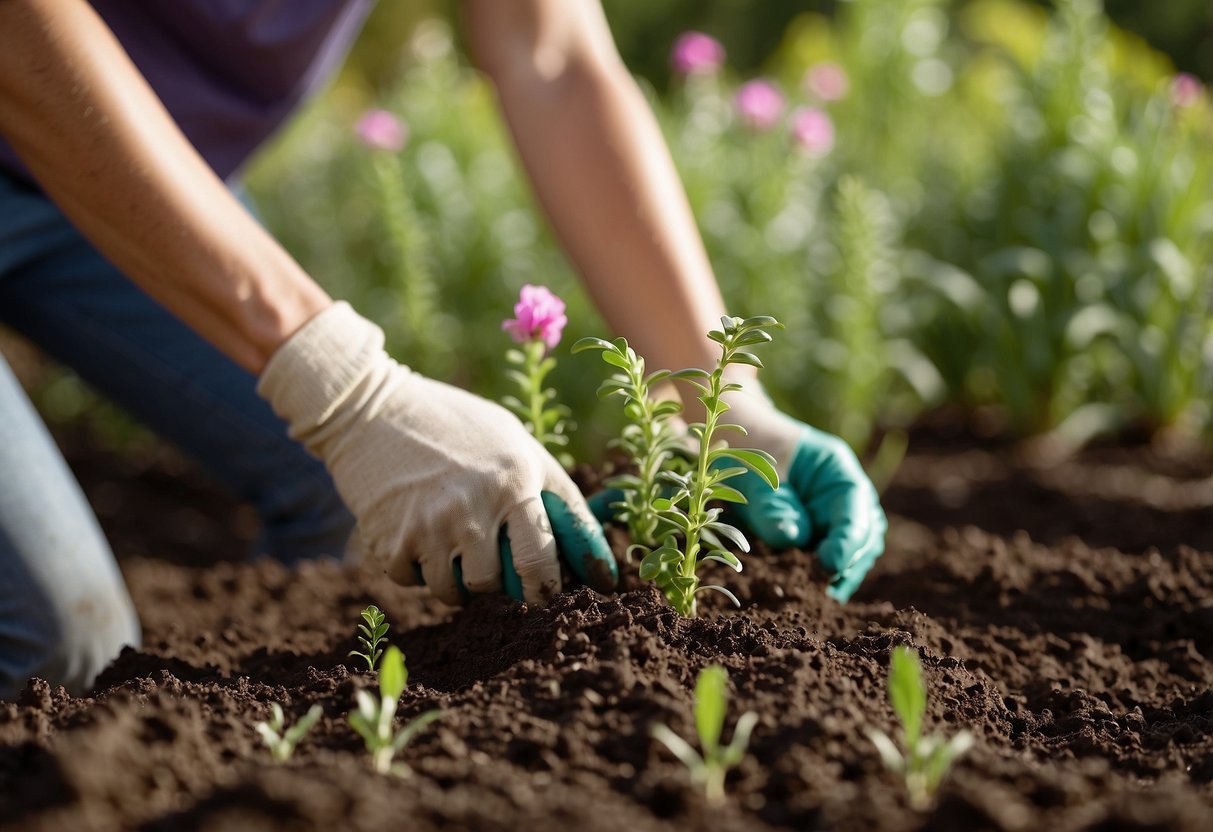Snapdragon Garden Ideas: Brighten Your Yard with Vibrant Blooms
Creating a snapdragon garden can transform your outdoor space into a vibrant, colorful haven. These charming flowers come in various shades and bring a touch of elegance to any garden. With a few thoughtful ideas and tips, you can effortlessly incorporate snapdragons into your gardening plans.

Are you ready to explore creative ways to showcase snapdragons in your garden? Whether you are a seasoned gardener or a beginner, there are endless possibilities to make these flowers the highlight of your yard. Dive in and discover how snapdragons can add beauty and whimsy to your garden.
1) Planting Snapdragons from Seeds

Snapdragons are lovely flowers to grow in your garden. Start by choosing a sunny spot that gets plenty of light.
Press the seeds lightly into the soil. The seeds need light to germinate, so don’t cover them with soil. Keep the soil moist.
You can use a humidity dome to maintain moisture until the seeds sprout. This usually takes 7 to 14 days.
Once the seedlings sprout, place them in a sunny spot. Keep the soil evenly moist to help them grow well.
2) Preparing Soil for Snapdragons

Before planting snapdragons, you need to get the soil ready. Start by loosening the soil to a depth of 12-15 inches. This helps the roots grow better.
Next, mix in compost or aged manure to improve soil fertility and drainage. For soils that are heavy clay, add sand or perlite to improve aeration.
Make sure you test the soil pH. Snapdragons prefer a pH between 6.2 and 7.0. Adjust it using lime or sulfur if needed. By doing these steps, your snapdragons will have a great environment to thrive in.
3) Selecting the Best Snapdragon Varieties

When choosing snapdragons for your garden, consider your local climate and soil. Snapdragons thrive in full sun to partial shade and well-drained soil.
For a stunning mix of colors, try the Cinderella series. These snapdragons bloom in shades like cream, yellow, and crimson.
If you have limited space, dwarf varieties are perfect. They grow only 6-15 inches tall and add vibrant color to small areas.
Trailing snapdragons can be a great choice for hanging baskets or ground cover, offering a cascading effect.
4) Companion Plants for Snapdragons

Snapdragons pair beautifully with many other plants. Consider planting them with licorice plants, petunias, or sage.
For a charming garden bed, combine snapdragons with alyssum. Alyssum provides a lovely ground cover.
Zinnias and marigolds are also great choices. These flowers attract pollinators and beneficial insects.
Snapdragons are especially good near tomato plants, attracting helpful insects.
5) Watering Tips for Snapdragons

Keep snapdragon seedlings moist during their first few weeks. Once they are established, water them about an inch per week if there’s no rain.
Water near the crown of the plant and avoid overhead watering to prevent disease. Let the top inch of soil dry out between watering.
Check the soil with your finger. If it’s dry an inch down, then it’s time to water.
6) Fertilizing Snapdragons Effectively

To keep your snapdragons healthy, use a balanced fertilizer with equal parts of nitrogen, phosphorus, and potassium. A 10-10-10 ratio works well for these plants.
You can apply slow-release, granular fertilizers. These are easy to use and release nutrients gradually.
Aim to use two pounds of fertilizer for every 100 square feet of garden space.
Mixing compost or aged manure into the soil also boosts fertility. Make sure to water your plants regularly to help absorb the nutrients.
For more details, check out this guide on fertilizing snapdragons.
7) Seasonal Care for Snapdragons

In spring, start snapdragon seeds indoors six to 12 weeks before the last frost. This gives them a head start before moving them outside.
During summer, keep snapdragons in full sun and water them regularly, about 1 inch per week.
In fall, you can winter-sow snapdragons by tossing seeds onto the garden soil. This can help them sprout when the weather warms again.
8) Pest Control in Snapdragon Gardens

Snapdragons can attract various pests. Aphids, mites, and mealybugs are common. These sap-sucking insects can cause damage by feeding on the plants.
Slugs and snails are also a problem. They leave large holes in leaves and slime trails. Regular checks can help catch these pests early.
To protect your snapdragons, use natural remedies or pesticides if necessary.
9) Pruning Techniques for Snapdragons

Start by removing spent flower stalks. Pinch off old blooms when they wilt to keep your snapdragons looking tidy. Trim a few inches below the wilted blooms if needed.
Identify any dead or damaged parts of the plant. Remove these stems and leaves to improve the plant’s health.
Next, focus on thinning out dense growth. This helps improve air circulation and light penetration, which encourages better blooms. You can also snip droopy stems to boost new flower production.
10) Creating Snapdragon Arrangements

When planning snapdragon arrangements, consider the height and colors of the flowers. Snapdragons come in various shades that can add a pop of color to your garden.
Mix snapdragons with other flowers like marigolds or zinnias for a vibrant display. Place taller snapdragons at the back and shorter ones in the front to create depth.
You can also plant snapdragons in containers. This allows you to move them around and change your garden’s look easily. Experimenting with different arrangements can make your garden unique and beautiful.
Planting Snapdragon Flowers

Planting snapdragon flowers correctly is essential for their healthy growth. Key considerations are choosing the right location and ensuring the soil is properly prepared before planting.
Choosing the Right Location
Snapdragons thrive in areas with full sun, though they can handle light shade in hotter climates. Gardens in USDA Zones 2-9 are ideal for full sun, with Zones 9-11 requiring light shade to prevent scorching.
Make sure the spot you choose has good air circulation. This helps prevent diseases like rust or mildew, which snapdragons are prone to. Avoid places where water might pool, as snapdragons prefer well-drained areas.
Keep threatened plants safe by spacing your snapdragons 12-18 inches apart. This spacing not only gives them room to grow but also improves air circulation, reducing disease risk.
Soil Preparation
Snapdragons grow best in well-drained, humus-rich soil. Start by loosening the soil to at least 12 inches deep. Mix in organic matter, like compost, to enrich the soil and improve drainage.
Snapdragons need more boron than other plants. Adding borax at a rate of 3 grams per square yard helps meet this need. Make sure your soil has a slightly acidic to neutral pH, ideally between 6.2 and 7.0.
Before planting, water the soil thoroughly but ensure it’s not waterlogged. This creates a moist environment for your snapdragons to settle in. Also, avoid using soil that stays wet for too long, as this could lead to root rot.
Caring for Snapdragon Gardens

Snapdragon gardens require precise watering and fertilizing to thrive. By following these key practices, you can enjoy vibrant, healthy plants.
Watering Techniques
Watering snapdragons correctly is crucial for their health. Keep seedlings moist during the first few weeks after planting. Once they are established, provide about 1 inch of water per week if there is no rainfall.
Water near the crown of the plant to avoid wetting the foliage. Overhead watering can cause diseases in snapdragons. Always let the top inch of soil dry fully before watering again. This prevents root rot and other moisture-related issues.
In hot weather, monitor the plants and adjust watering frequency as needed. Consistent watering helps snapdragons develop strong roots and produce abundant blooms.
Fertilizing Tips
Snapdragons benefit from regular fertilization. Start by adding a balanced fertilizer to the soil during planting. Use a formula like 10-10-10 to provide equal parts nitrogen, phosphorus, and potassium.
Once plants are growing, apply a liquid fertilizer every four to six weeks. This keeps the soil nutrient-rich and supports continuous blooming. Always follow the manufacturer’s instructions to avoid over-fertilization. Too much fertilizer can damage the plants and reduce flower production.
If your snapdragons appear weak or discolored, they might need more nutrients. Consider using a slow-release fertilizer for steady feeding throughout the growing season. Proper fertilization ensures your snapdragons remain vibrant and robust.







